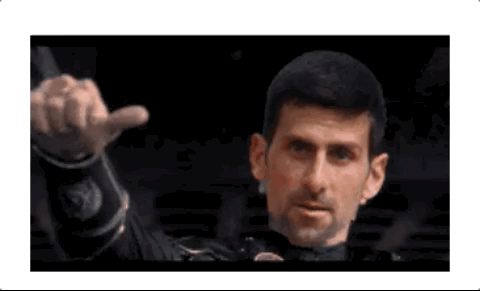How Novak Djokovic beat Stefanos Tsitsipas at the 2021 French Open
How did Novak Djokovic beat Stefanos Tsitsipas to win his second French Open title? I've analysed their titanic final to determine the answer.
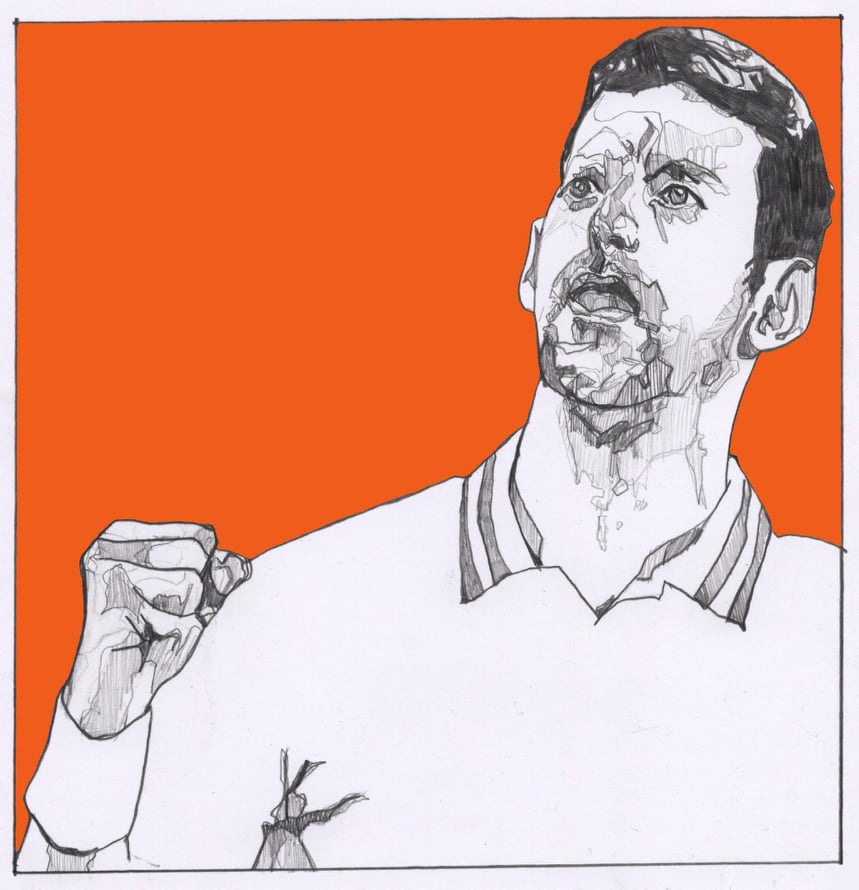
If you enjoy the article, please don’t forget to subscribe!
Last week, Novak Djokovic beat Stefanos Tsitsipas in the French Open final to lift the Coupe des Mousquetaires for a second time in his career.
We’ve already analysed his two sets comeback against Lorenzo Musetti and his four-hour epic against Rafael Nadal - now we’re here to analyse his four-hour, two sets comeback against the young Greek.
… Sorry, I know, I know - the grass-court season is already in full swing, I’m a bit late to the party, yada yada yada.
Apologies for the tardiness…
Enjoy!
French Open Final: Novak Djokovic defeats Stefanos Tsitsipas 6-7 (6) 2-6 6-3 6-2 6-4
Stefanos Tsitsipas was playing the first Grand Slam final of his career. Armed with a mighty serve and potentially the best forehand of the Next Gen, he’d taken down his peers Daniil Medvedev and Alexander Zverev in the previous two rounds.
Novak Djokovic was playing his 29th Slam final. He’d dethroned the King of Clay and screamed in relief on beating Matteo Berrettini in an empty stadium. Lorenzo Musetti had had him on the ropes in the fourth round before he had stormed back to win 16 of the last 17 games.
Tsitsipas had nothing to lose. Djokovic had survived some incredibly stern tests. Who would be more motivated in the final?
Tsitsipas wins the first two sets: 7-6 (8) 6-2
Free from the burden of expectation, the Greek came out swinging. He scraped through the first set and dominated the second. Here are a few factors that allowed Tsitsipas to forge a two sets to love lead.
1. Tsitsipas’s loaded forehand
The Tsitsipas forehand is one of the heaviest in the game.
With a topspin rate comparable to Rafael Nadal (around 55rps), Tsitsipas is able to push his opponents well behind the baseline with this weapon. In the first two sets, he was winning the majority of the forehand to forehand cross-court rallies, rushing Djokovic’s forehand nicely, particularly in the second set.
Tsitsipas FH winner/forced error to FH unforced errors in first two sets: 14-8
Djokovic FH winner/forced error to FH unforced errors in first two sets: 16-10
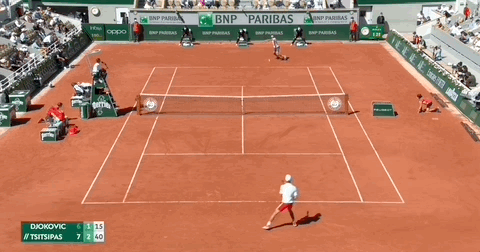
Tsitsipas also frequently ran around his forehand to hit the second serve return, often giving himself the upper hand in the rally. This was key to Tsitsipas winning 65% of Djokovic’s second serve points in the first and second sets.
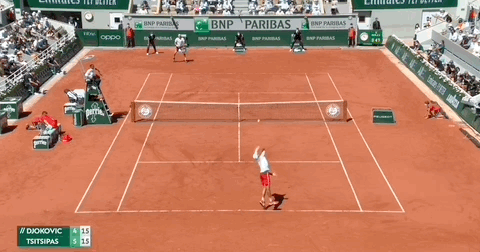
Matching Djokovic’s forehand is an impressive feat in itself, which he did for most of the first set. Out playing it like he did in the second set is another thing entirely, allowing him to dictate many of the extended rallies.
If you didn’t catch my Nadal-Djokovic analysis, I touched on the fact Djokovic has always dominated the longer rallies in their matches.
Along with winning the shorter points, Tsitsipas actually won the majority of the rallies that went beyond five shots in the second set, testament to how much of a weapon the forehand was for Tsitsipas.
2. The topspin backhand was solid AF
In the second set, Tsitsipas played a backhand on 37% of his groundstrokes, his least for any set. The forehand stole the show there as he was able to consistently dominate on this wing.
In complete contrast to the second set, however, Tsitsipas played a backhand 46% of the time in the first set, his most for any set. For two sets, he was solid as a rock behind this wing.
Tsitsipas BH winner/forced error to BH unforced errors in first two sets: 3-2
Djokovic BH winner/forced error to BH unforced errors in first two sets: 3-5
Whilst the forehand played its part in the first set, it was the solidness of his backhand that stopped Tsitsipas from being bullied from the baseline.
This stemmed from the frequency with which Tsitsipas was able to hit a topspin backhand. You see, though Tsitsipas hit his highest percentage of backhands in the first set, his total percentage of backhands sliced rather than topspun was lower than any other set (we’ll get onto the Tsitsipas slice… for now, all you need to know is Tsitsipas slice = bad juju).

Though Tsitsipas played more backhands than any other in the first set, he played a significantly lower percentage of slices per backhand played.
Tsitsipas didn’t overwhelm Djokovic with the backhand but driving the ball with plenty of topspin made it more dependable for two sets than arguably the greatest backhand of all time1.
3. Djokovic was average on second serve return
In the first set, Tsitsipas showed the power of his first serve at its best, placing the serve well to ace Djokovic seven times.
Too good, no problems there.
The second serve, however…
First off, Tsitsipas has a decent second serve. It’s fairly quick and he can back it up well against most players on clay.
You’ll probably be aware, however, that Novak Djokovic ain’t most players.
For two sets, Djokovic looked like a basic bitch on second serve return as he was unable to capitalise on the abundance of Tsitsipas’s second serves directed towards his body2.
In the first two sets, Djokovic was only able to win three points on Tsitsipas’s second serve in the 0-4 shot rally length (to win a point of this length as a returner, you’d most likely need to hit a good return).
This is equivalent to one in every eight of Djokovic’s second serve returns.
In the final three sets, Djokovic won thirteen points on Tsitsipas’s second serve in the 0-4 shot rally length.
This is equivalent to one in every three of Djokovic’s second serve returns, a massive difference.
Well, Tsitsipas’s second serves were probably better in the first two sets, right?
Quite the contrary!
Take a look at this chart below.

As Djokovic settled on return, Tsitsipas felt the pressure to hit a riskier second serve, increasing their speed and placement in an effort to keep up with Djokovic’s level of play.
The bottom line?
Djokovic took a while to settle into his return of serve and allowed Tsitsipas to rack up second serve points he shouldn’t have been winning.
In the first set in particular, where the players were separated by just one point3, this dip from Novak was immensely important.
In the second set, the problem was worse. Djokovic was straight up hitting unforced errors on second serve returns *gasps*.
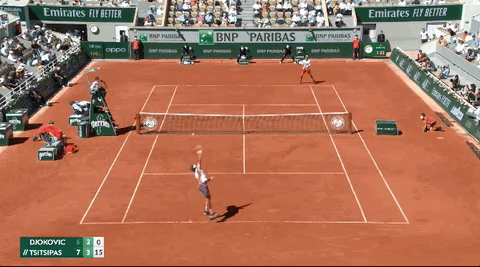
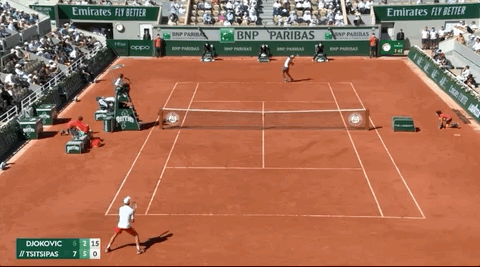
Djokovic said there was a drop in his form after the first set which kinda explains the unforced errors.
“Second set I dropped physically and mentally, I just got fatigued a bit and allowed him to dominate the second set.”
With all of this in mind, what changed for Djokovic to make a dramatic comeback?
Djokovic wins the final three sets: 6-3 6-2 6-4
The first couple of games went as scripted. Tsitsipas held comfortably and Djokovic held less comfortably.
Then this happened…

Both Djokovic and Tsitsipas described Djokovic’s transformation in the third set in the same way.
“He left the courts after two sets to love down… he came back a different player.”
“Then I went out from the court, as was the case against Musetti in the fourth round, and I came back a different player.”
Here are the two main factors that made Djokovic seem “a different player” from this turning point.
1. Locking into the return
We discussed some of these numbers earlier so I won’t dive too far into them again.
Novak increased his amount of meaningful second serve returns (points won in 0-4 shots) from one in eight to one in three, despite Tsitsipas’s second serve speed and placement increasing as the match went on.
This was somewhat the case with the first serve also. Excluding the second set where Djokovic looked noticeably tired, Tsitsipas won a similar amount of points on his first serve throughout every set4.
When Djokovic did get a hold of the return, however, he made it count.
In the first two sets, Djokovic was only able to win three points on Tsitsipas’s first serve in the 0-4 shot rally length.
This is equivalent to one in every 13 of Djokovic’s first serve returns.
In the final three sets, Djokovic won 14 points on Tsitsipas’s first serve in the 0-4 shot rally length.
This is equivalent to just under one in every five of Djokovic’s first serve returns.
In other words, Djokovic was successfully more aggressive on his first returns when he had the opportunity yet Tsitsipas's first serve percentage remained constant throughout the match (bar the second set) - it’s not a leap to say Tsitsipas’s first and second serve level didn’t really drop as the match progressed.
No change in return position from Djokovic.
No drop off in service speed or placement from Tsitsipas.
Just a hard reset from Novak and an aggressive mindset to pressurise the Tsitsipas serve after dipping in the second set, leading to a slew of second serve return points won.
2. Djokovic forces the slice with his forehand down the line
Compared to his other shots, Tsitsipas’s slice is a relatively weak shot.
Part of the reason for this is how often he plays the slice with an open stance rather than a closed stance. A lot of power and control is lost hitting the slice with the left leg in front which can often lead to Tsitsipas’s slice floating or staying fairly central, giving Djokovic an easy put-away (see Matthew Willis’s brilliant Twitter thread of this here for a deeper explanation).


This was apparent even in the first two sets. Tsitsipas won four of the 17 points where he’d hit a slice (about 24%) - Djokovic just hadn’t been able to rush him as often as he’d have liked.
Djokovic accordingly changed the direction of his forehand to try to exploit this weakness.
In the first two sets and up to the turning point (third set, 2-1, 40-15), Djokovic hit a forehand up the line in 10% of the total points played and Tsitsipas played a slice on 19% of his total backhands hit. Beyond the turning point, the Djokovic forehand up the line featured in 16% of the total points played, resulting in Tsitsipas increasing his slice usage to 26% of his total backhands hit.
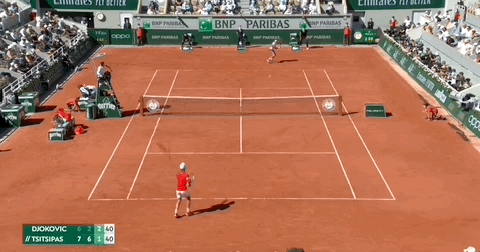
Forcing this play on his own serve was particularly successful. In the final three sets, the Tsitsipas slice featured in one of every five Djokovic’s service points and Djokovic lost just one of these points.
Just one solitary service point featuring a Tsitsipas slice.
This was one of the reasons Djokovic didn’t face a single break point in the final three sets.
Tsitsipas’s total points won percentage featuring his slice for the final three sets was identical to the first two sets, at 24%.
After the match, Tsitsipas did note that he suffered from hip blockage in the third and fourth sets which was also when his slice made its most appearances. This may have stunted his movement in getting to his backhand wing and perhaps also stopped him from playing less slices.
Nevertheless, Djokovic did well to recognise an existing winning pattern of play in the two sets he’d lost and did even well-er to increase the frequency of this pattern of play.
How Novak Djokovic beat Stefanos Tsitsipas at the 2021 French Open
So, here’s how the first two sets went.
Djokovic was far from his best on return, preventing him from pressurising Tsitsipas’s second serve.
Tsitsipas hit aggressively from the forehand, particularly cross-court and in the second set.
Tsitsipas was getting to his backhands in plenty of time, allowing him to hit a solid topspin backhand.
And here’s how the final three sets went.
Djokovic raised his level on return, particularly on Tsitsipas’s second serve, even though Tsitsipas’s service delivery remained consistent with the first two sets, if not better.
Djokovic started to direct his forehand down the line to draw out the Tsitsipas slice. This was exacerbated by an injury to Tsitsipas’s hip. Tsitsipas was left ineffective on Djokovic’s service games.
According to Tsitsipas’s post-match press conference, his injury started to clear up in the fifth set. The slice frequency decreased somewhat (it was still significantly higher than the first set, however) and he played some fantastic points under pressure. Unfortunately, his first serve percentage dropped and Djokovic rode one break of serve to the finish line.
Drop shots, volleys and clutch shots aside, these are the main factors that influenced the course of the match.
For Tsitsipas, though he may not have won, he’ll have learnt what’s required of him to make that extra step. The slice backhand isn’t a necessity for greatness on clay but it would absolutely help him develop a back-up plan or two and, for all the success of his second serve, it may need to be improved against the best returners in the game.
For Djokovic, this is another nail in the Next Gen’s coffin.
Two sets up? Not a problem!
Will he do it all again over the next three weeks? I’ll be covering Wimbledon to let you know how the story develops…
I know my articles have been pretty dense recently so I’ll make sure the next instalment is delightfully light.
Other French Open 2021 articles if you’re interested:
Analysis of Novak Djokovic’s semifinal win over Rafael Nadal here.
Analyses of the women’s French Open winner, Barbora Krejcikova’s, final two matches here.
Men’s Fourth Round analysis here.
Women’s Third Round analysis here.
Men’s First Round analysis here.
Thanks to tennisabstract.com and rolandgarros.com for many of the statistics.
If you enjoyed this article, you can click the subscribe button below for weekly updates or you can support the dream by clicking below that. Thanks very much for hanging around this long!
Also, follow me on Twitter (@jackedward1994) and Instagram (@jack221194)!
There may be some truth to Djokovic struggling against one-handed backhanders on clay. His losses at Roland Garros would certainly suggest so. Bar Nadal, the last four players he’s lost to in Paris are as follows; Dominic Thiem, Marco Cecchinato, Stan Wawrinka and Roger Federer…
All one-handers.
As a rule of thumb, one-handers generate more topspin on their backhands so they can be tougher to breakdown on this wing on the red dirt. They also hit higher into Djokovic’s backhand, who is more comfortable hitting the backhand lower.
At the same time, analyses have been posted for all four losses; against Thiem and Federer, Djokovic won the majority of the rallies that included a one-handed backhand (60% and 58%, respectively); against Cecchinato and Wawrinka, he won the minority (45% and 40%, respectively).
Does he struggle against one-handers on clay? Is it just coincidence? Let me know what you think in the comments!
There are three options when serving - you can serve wide, to the body or down the tee. On a second serve, a serve to the body is the safest option in terms of avoiding a double fault but it may give the returner more time to line up their response.
Here’s a comparison to give you an idea of how safely Tsitsipas placed his second serve. Tsitsipas landed a second serve in the middle of the court 40 times. Though Djokovic’s second serves are somewhat slower, his placement is comparably outstanding as he landed a second serve in this portion of the court only four times.
In the first set, Tsitsipas won 43 points, Djokovic won 42 points.
First serve won for Tsitsipas:
Set 1: 62%
Set 2: 87%
Set 3: 65%
Set 4: 65%
Set 5: 64%




